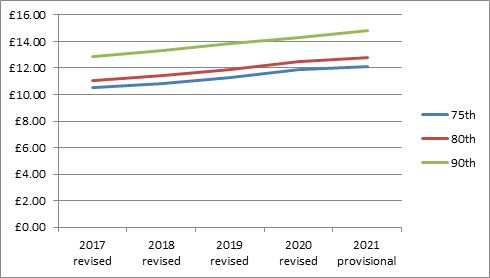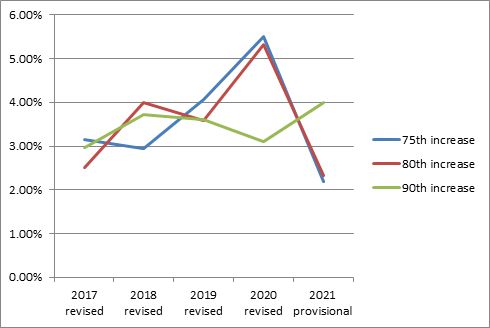On 26 October 2021 the Office for National Statistics released the latest data from the Annual Survey of Hours and Earnings (ASHE). These are provisional figures based on estimates of income from a 1% sample of workers' HMRC records for the tax year ending 5 April 2021, and they will be revised and updated in due course as the data is finalised. The provisional data provides a steer on how the earnings across all industries are changing. Those dealing with catastrophic injury claims will be particularly interested in the data relating to care workers as the rates are directly applicable to the recalculation of existing periodical payment orders.
The latest data shows an average increase in care rates across the 60th-90th percentile of 2.6%. Practitioners will be aware that the hourly rates actually compensated within a catastrophic injury claim are typically significantly higher than those quoted in ASHE, given that ASHE covers all care workers (most of whom are state funded) whereas a catastrophic injury claim is typically compensated on the basis of a private care package which can be twice the hourly rates quoted within ASHE. That being said, the rates might offer an indication of trends in care costs generally.
It is apparent from the latest data that the general annual increase in the earnings of care workers across different percentiles continues, as shown in these examples:

However, that level of increase has been far from steady, and does not show an obvious trend from which one can easily predict continuing steady increases in care earnings, as demonstrated when comparing the same data above in terms of annual earnings increases year on year:

The data shows that the extent of increase for the 75th and 80th centile has dropped this year compared with last year, whilst at the 90th centile there has been a lesser increase compared with the comparative increase last year. There have of course been a number of destabilising factors for the economy over the last couple of years, not least the dwindling public finances resulting from the pandemic and the potential for increased costs of delivering care within the restrictions of the pandemic. At the same time though, the pandemic has generated greater public consciousness (and political motivation) to recognise the contribution made by carers, there are increasing reports of labour shortages within the care sector and we now know that the budget will deliver an increase in the national living wage, all of which is only likely to drive rates up.
The publication of this data was subject to clear caveats by the Office for National Statistics that interpreting average earnings data is currently very difficult due to the effects of the pandemic and disruption in the usual collection of data. Whilst an increase in care costs was expected, the level of that increase is lower than might have been expected. All things considered, the ASHE data and the trends that it is currently showing seems to underplay the experience of practitioners dealing with ever increasing private packages. This only emphasises the need for more bespoke data collection and analysis by those operating in this field which is more specific to understanding the trends occurring within catastrophic injury claims.
The content of this article is intended to provide a general guide to the subject matter. Specialist advice should be sought about your specific circumstances.


